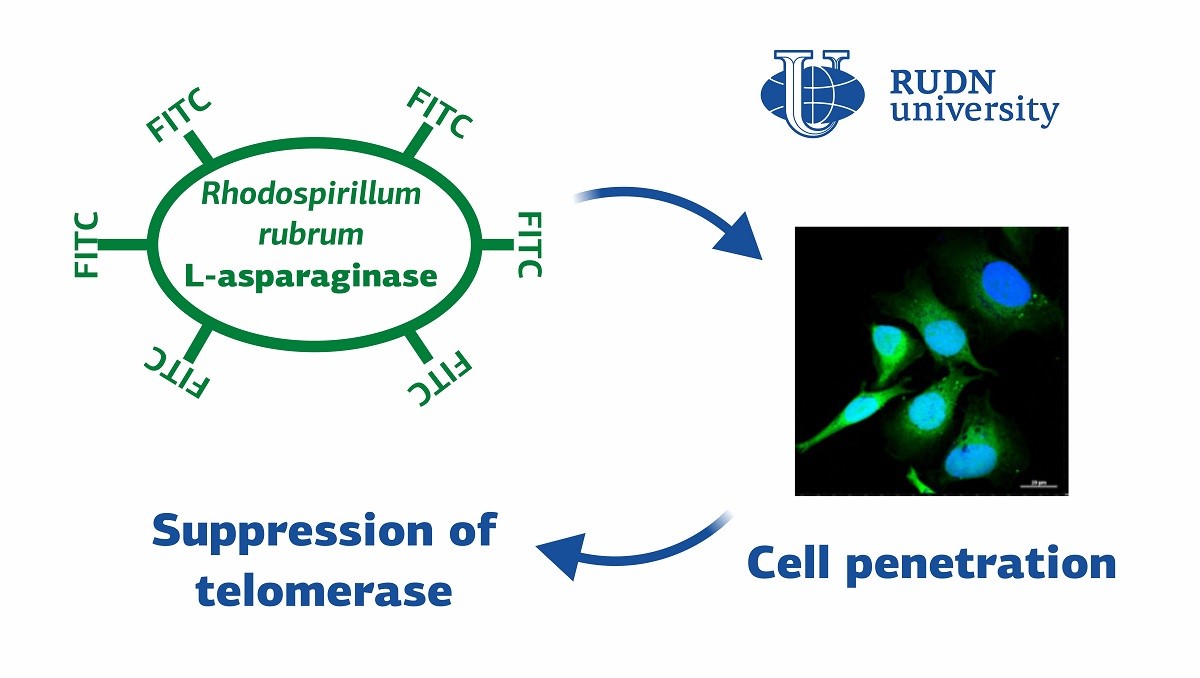RUDN medic discovered how antitumor enzyme penetrates cancer cells

Cells, including cancer cells, need the amino acid asparagine for metabolism. Healthy cells produce it themselves, but cancer cells cannot do this, they depend on the intake of asparagine from the outside. The enzyme asparaginase destroys asparagine, therefore, under its action, cancer cells die due to the lack of the necessary asparagine. In addition, asparaginase has other mechanisms of action unrelated to asparagine. For example, asparaginase RrA, which is produced by the purple bacterium Rhodospirillum rubrum, suppresses the activity of the enzyme telomerase. It does not allow chromosomes to shorten during cell division, and therefore it is called the main cause of the “immortality” of cancer cells. This happens inside the cell or even inside the nucleus, that is, the RrA is able to pass through the cell membrane. How exactly — it was still unknown. RUDN physician for the first time described the mechanism by which this happens.
“The antitumor effect of asparaginase is explained by its ability to decompose asparagine in the bloodstream and in the environment of cancer cells. Rru has a dual mechanism of action and plays a role in suppressing telomerase activity. The purpose of our work was to study the mechanism by which RrA penetrates into human cancer cells,” said Vadim Pokrovsky, Doctor of Medical Sciences, RUDN Head of the Department of Biochemistry.
In the experiment, doctors used eight human cancer cell lines, including breast cancer. The researchers “tagged” the RrA using fluorescent isothiocyanate substances and placed them in prepared cell cultures. Then the doctors observed how the enzyme moves inside the cancer cells using fluorescence microscopy and flow cytometry.
It turned out that the penetration of RrA occurs with the help of the clathrin protein. The mechanism of penetration is receptor-mediated endocytosis. A “pit” is formed on the cell membrane — a bulge inside the cell. Ra molecules combine with clathrin molecules inside this fossa. After that, closed vesicles form from the pit, which turn out to be inside the cell. Then the walls of the vesicle disintegrate, and the enzyme enters the cell, and katrin returns to the membrane.
Researchers also found two structure motifs in RrA — sequences of amino acids — with which the enzyme acts inside the cell nucleus. They allow RrA to get into the cell nucleus, where it blocks the action of telomerase — this prevents cancer cells from dividing.
“For the first time, we were able to show the intracellular localization of RrA in human breast tumor cells. Our study demonstrated that different L-asparaginases can have complex mechanisms of antitumor activity, including regulation of RNA synthesis. Thus, RrA can potentially be used as an antitumor enzyme with a dual mechanism of action,” — added Vadim Pokrovsky.
The results are published in the journal Pharmaceuticals.
Matilda Pavlovna Mityaeva was born in 1925. In November 1942, she volunteered for frontline duty. She participated in the Great Patriotic War from November 1942 to June 1945 as part of the 53rd Infantry Division of the 475th Infantry Regiment. She was wounded twice.
The team led by Sergey Zyryanov, Head of the Department of General and Clinical Pharmacology, became the winner of the All-Russian competition of scientific projects "Technologies for Human Health".
RUDN University constantly adapts to the changes of the modern world and responds to challenges flexibly. This allows us to keep the standard of a world-class research university. The sphere of science is no exception. Peter Dokukin, Head of the Research Division, presented the updated R&D Programme at the meeting of the RUDN University Academic Council.
Matilda Pavlovna Mityaeva was born in 1925. In November 1942, she volunteered for frontline duty. She participated in the Great Patriotic War from November 1942 to June 1945 as part of the 53rd Infantry Division of the 475th Infantry Regiment. She was wounded twice.
The team led by Sergey Zyryanov, Head of the Department of General and Clinical Pharmacology, became the winner of the All-Russian competition of scientific projects "Technologies for Human Health".
RUDN University constantly adapts to the changes of the modern world and responds to challenges flexibly. This allows us to keep the standard of a world-class research university. The sphere of science is no exception. Peter Dokukin, Head of the Research Division, presented the updated R&D Programme at the meeting of the RUDN University Academic Council.